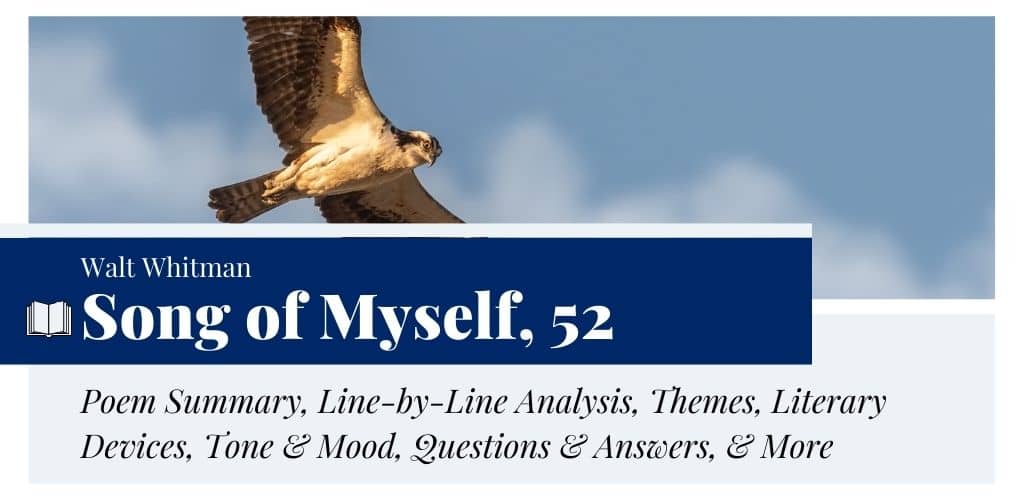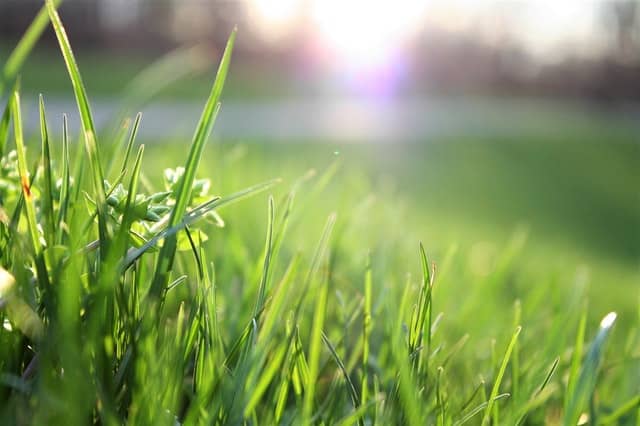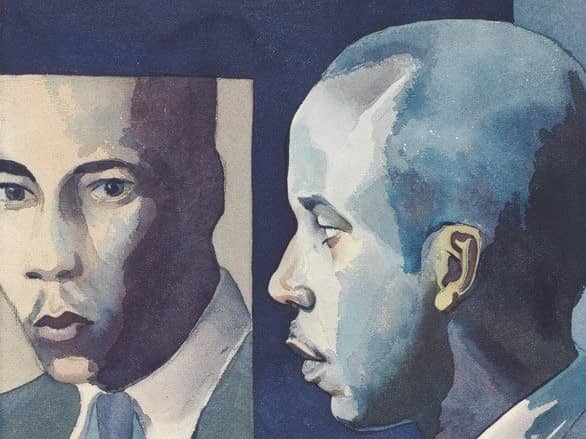Song of Myself, 52 by Walt Whitman
“Song of Myself, 52,” also referred to as “The spotted hawk swoops by,” form the concluding sixteen lines of Walt Whitman’s most remarkable poem of all times. This section of Whitman’s poem, in its entirety, is about the drama of identity that unfolds as the poet explores his limits. In this brief ending to an otherwise verbose poem, Whitman fleetingly speaks about his incomprehensible or “untranslatable” self while also encouraging the reader to understand him.
- Read the full text of “The spotted hawk swoops by” below:
Song of Myself, 52: The spotted hawk swoops by by Walt Whitman The spotted hawk swoops by and accuses me, he complains of my gab and my loitering. I too am not a bit tamed, I too am untranslatable, I sound my barbaric yawp over the roofs of the world. The last scud of day holds back for me, It flings my likeness after the rest and true as any on the shadow'd wilds, It coaxes me to the vapor and the dusk. I depart as air, I shake my white locks at the runaway sun, I effuse my flesh in eddies, and drift it in lacy jags. I bequeath myself to the dirt to grow from the grass I love, If you want me again look for me under your boot-soles. You will hardly know who I am or what I mean, But I shall be good health to you nevertheless, And filter and fibre your blood. Failing to fetch me at first keep encouraged, Missing me one place search another, I stop somewhere waiting for you. - from Leaves of Grass (1855)

Summary
Whitman’s “The spotted hawk swoops by” from its very onset reads like a poem that is addressed specifically to the readers. It begins with a hawk swooping down on the narrator, owing to his excessive rambling and loitering about. Whitman, the recognized speaker of the poem, on finding out about this hawk, immediately identifies with it. He draws a parallel between himself and the hawk since, according to him, they are both traveling in the same boat, experiencing the same emotions. Just like the hawk, the narrator feels that he is “untamed” and just as “untranslatable” as the hawk’s cry is. There is a sense of familiarity that Whitman uses to further build his poem.
Moving along, Whitman dives right into the comfortable essence of nature like any other transcendentalist poet of his time. He perfectly executes the merger of human harmony with nature; this coexistence comfortably runs throughout the poem’s space. The poet then continues with the same tendencies and describes in laced metaphors how the day patiently waits for him to be fully prepared and only then does the sun go down. This transition to darkness is an appropriate reflection of death. The next pit stop in Whitman’s journey is centered around this very idea of the cycle of life.
Hence, by the end of the day, the poet is persuaded away, and he floats farther with the wind, discarding his flesh. He, in this sense, surrenders to the earth, giving himself up even to the other elements of nature. This symbolic imagery links together the idea of dead bodies being buried. Readers need to look at the earth beneath their feet if they want to find Whitman. Even if they have never met him, he will be beneficial to them. This prominent idea of brotherhood and affection gives Whitman’s poetry a definite edge.
Even if readers cannot locate the author, they are encouraged to continue looking. Although they cannot really know who he is when they finally locate him, he will shower his wisdom on them, regardless. People who walk over him or pass his grave will certainly be blessed with paramount excellence and health.
Structure & Form
Whitman’s “The spotted hawk swoops by” consists of sixteen lines that run along almost the same length. The poem, like most of Whitman’s experimental writings in “Song of Myself,” lacks a standard and regular rhyme scheme and metrical pattern, making it a free-verse poem. Despite being written in this form, the poem maintains a slight cadence and rhythm. This is due to the poetic devices like slant rhyme or internal rhyme used in the poem along with the systematic use of alliteration. Whitman also provides a specific structure to this poem by the repetitive use of the pronouns “you” and “I” while addressing the speaker and readers. The narrator addresses readers by referring them to a hawk. The tone and stance are personal and brim with the exploration of the speaker’s identity.
Literary Devices & Figurative Language
While reading Whitman’s “The spotted hawk swoops by,” readers come across the use of the following literary devices:
Imagery
In poetry, imagery is a term used to describe parts of writing that appeal to the five senses. This device assists the readers in creating a better mental picture of the action that takes place in the course of the poem. Whitman, among other transcendentalist poets, is popular for the use of vivid nature imagery in his poems. While reading “The spotted hawk swoops by,” it is impossible to overlook the use of this poetic technique.
- Animal Imagery: Right from the beginning, readers can pick on the animal imagery that lingers in the poem. The mention of the “hawk” certainly brings a sense of purpose. The hawk that “swoops by” also helps readers in picking up the setting and mood of the poem.
- Auditory Imagery: Apart from the very obvious animal imagery, there is also some prominent auditory imagery that can be picked on very early in the poem. For instance, “I sound my barbaric yawp over the roofs of the world.” In this line, the “sound” of Whitman’s “barbaric yawp” ironically becomes the standard that gives weight to the poem. The “barbaric yawp,” therefore, remains unsilenced.
- Visual Imagery: There is an abundance of visual images in Whitman’s poem. The mention of “grass” in lines like “I bequeath myself to the dirt to grow from the grass I love,” makes use of some very strong visual inputs. This not only helps build on the setting of the poem but also portrays the importance of nature, which is quite a deal while reading the American transcendentalists.
- Color Imagery: The lines like “I shake my white locks at the runaway sun,” brings out the color imagery. This particular poetic technique aids in creating a richer reading experience, as it has the power to instantly decide as well as alter the tone and mood. Therefore, the “white locks” in a sense help the speaker bring the idea of aging closer to home before diving right into the darkness of death.
Parallelism
Parallelism is a literary device that works on the idea of resemblance and connection. When an author creates sections of a sentence to be grammatically similar, typically repeating a single word, phrase, or idea, this is referred to as parallelism. This repetition establishes a link between the concepts enclosed in the poem, such as in the lines “I too am not a bit tamed; I too am untranslatable.” This repetition adds a certain significance to the similarity that the speaker wants to trace between himself and the hawk. The parallelism helps arrange the idea in better words, making the narrative attention-grabbing while still being simplistic.
Anaphora
Anaphora is a poetic device that involves the repetition of a word or phrase at the onset of subsequent sentences or clauses. In “The spotted hawk swoops by,” Whitman very cleverly employs this technique in the lines:
I too am not a bit tamed; I too am untranslatable.
This method of systematic repetition in a small poem adds really well to the flow and movement of the verse. Hence, Whitman’s use of this technique not only imparts rhythm to the poem but also strengthens the earlier mentioned employment of parallelism.
Metaphor
This poem is filled with the use of distinct metaphors that add layers of meaning and significance to the otherwise monotonous and strategic writing. One of the most prominent examples of metaphor is when the poet mentions, “I effuse my flesh in eddies, and drift it in lacy jags.” The metaphor awards greater emphasis on the already discussed theme of dissolving into nature.
Alliteration
Alliteration, in poetry, is the occurrence of a particular sound at the beginning of neighboring words. Whitman beautifully employs this poetic device to further provide a sense of the occasional rhythm and continuity in the poem. On examining the poem closely, it is easy to find out the use of this technique right from the beginning, i.e., “The spotted hawk swoops by.” There are other lines where readers can find the use of alliteration, for instance:
- “And filter and fiber your blood”
- “Failing to fetch me at first keep encouraged”
Personification
The use of personification is nearly impossible to miss. The very beginning of the poem contains this poetic device:
The spotted hawk swoops by and accuses me, he complains of my gab and my loitering.
The speaker describes how the hawk, a bird that cannot originally speak, “accuses” and “complains” of his excessive talking and waiting. In doing so, Whitman attributes human qualities to the hawk. This intensifies the development of the poem and even makes the verse seem richer and poise.
Repetition
Another literary device used to emphasize or create an echo of a specific idea is repetition. Whitman, in his poetry, is often seen stressing the use of the pronouns “you” and “I.” This is true of “The spotted hawk swoops by” too. He repeats the phrase “I am” or the pronoun “I” more than just a couple of times. This brings home the idea that the poem is situated around the speaker’s self. He makes it a point to deliver to readers that what they are encountering in the form of this poem is highly personal, but it is just as subjective as any poetry is supposed to be.
Line-by-Line Analysis & Explanation
Line 1
The spotted hawk swoops by and accuses me, he complains of my gab and my loitering.
At the beginning of Whitman’s “Song of Myself, 52: The spotted hawk swoops by,” just as the name suggests, the speaker introduces a hawk. This hawk suddenly appears in the scene, “accusing” the speaker. It is important to look at the word “accuses” in this line. The hawk, a mere passer-by, a creature whose language is indecipherable, is “accusing” and “complaining” about the speaker’s behavior. The speaker, who is aware of its discontent, tells readers that the hawk is angered by his ongoing rambling.
On a closer analysis of this line, it can be concluded that Whitman, in this section of “Song of Myself,” is addressing his own concerns about having said a lot in due course that goes on for more than a thousand lines. He is voicing both his own criticism and what he thinks readers might feel. His “gab” and “loitering” are a cause of apprehension. The hawk, therefore, is a representation of both the speaker’s own conscience and what he imagines his audience would say.
Lines 2-3
I too am not a bit tamed, I too am untranslatable,
I sound my barbaric yawp over the roofs of the world.
In these lines, Whitman draws a parallel between his persona and the hawk. He is transcendental in his approach, where he digs deeper within the linguistic queerness of the hawk’s world. The intricacies of the conflicting world remain alienated in the pursuance of linguistic chauvinism. For Whitman, the poem becomes a source to let out his intimate anxieties, fears, and frustration towards the ontological tangent of communication or its inability thereof.
In the second line, the word “barbaric yawp” has different connotations, considering the time it was written in. It is often said to refer to the paradoxical, experimental, and unaltering methods of writing that Whitman opted for. He believes that his words will echo through the “roofs of the world.” These perpetuated voices become louder and louder as they form an inevitable part of one’s being.
Lines 4-6
The last scud of the day holds back for me,
It flings my likeness after the rest and true as any on the shadow’d wilds,
It coaxes me to the vapor and the dusk.
As the poem progresses, Whitman further indulges in the complexities of nature and the fragile human existence. In these lines, he portrays nature as an empathizing force where it patiently waits for him to smoothly walk over the bridge of transition from his life in this space and time to another. As time approaches, death becomes an inevitable truth for the speaker, as for any other living creature that steps into the mystifying world of treasures and unraveling horrors. Whitman carries in himself a delicate picture of death and life and, through the poem, he eventually gets absorbed by the nature itself.
Lines 7-8
I depart as air, I shake my white locks at the runaway sun,
I effuse my flesh in eddies, and drift it in lacy jags.
Through these lines, the poet further strengthens his connection with the forces of his surroundings. He unboxes some rather effacing truths of the world. Here, he manages to curate a magnificent yet transient image of both his mortal being and the eddies of nature. In this most simplistic verse, he mentions the very complex process of merging with the elements of nature.
The “runway sun” and “white locks” impart the poem with very beautiful color imagery. In addition to this, the grappling portrayal of the human flesh that is submerged in the water adds another layer of meaning to the poem. At this point, readers witness the beginning of the process where Whitman and nature start identifying as one single entity.
Lines 9-10
I bequeath myself to the dirt to grow from the grass I love,
If you want me again look for me under your boot-soles.
In these lines, the poet finally brings to a conclusion the idea that he presented earlier. He reminds readers once again of his transformation. He says that he bequeaths himself to the dirt, i.e., he commits himself to the earth. The image of “grass” in this couplet is something to pay attention to. It seems the grass occupies an important position in Whitman’s poetry. The idea of him submitting to the underground, i.e., the grave, only brings out another almost surreal image of him blossoming as bright green blades of grass. This symbolic interpretation of nature does not let the poem get too grainy even when it constantly traverses through the realms of the dark, oblivious, and uncertain death.
In the next line, Whitman adopts a more conversational tone. He goes on to address the reader directly. While talking to his audience, he tells them that in case anyone wants to come looking for him, they should do so by looking under their feet. He says this to bring home the thought that though he is nowhere to be found, symbolically, he is everywhere. Every particle that once belonged to him is now one with the earth. He is in the grass that he so adores, the compost, the dirt beneath boots, and so on. He is a part of the living world, in definition, and the living world is very much still a part of him.
Lines 11-13
You will hardly know who I am or what I mean,
But I shall be good health to you nevertheless,
And filter and fiber your blood.
Whitman maintains his conversational tone in this tercet. While still addressing the audience, he informs them of the brotherly and giving nature of his newfound means of existence. He makes it a point to convey to his audience that though this new manner of his being renders him a mystery to the normal world, and one might not know where to look for him, he is always going to be around to help whoever as much as passes him by.
Lines 14-16
Failing to fetch me at first keep encouraged,
Missing me one place search another,
I stop somewhere waiting for you.
Whitman ends the poem on an encouraging note. He motivates the reader to keep looking for him in different places. Thus, he tries to keep the momentum by establishing his presence in readers’ hearts and minds. Through the ending, he conveys the fact that even when people leave this earth, they are etched somewhere in the corners of memories and carved into the mundane yet mesmerizing events of everyday life. On this journey toward the ultimate truth, the poet assures readers that there will be a place and time where the people that he holds close to himself will inevitably find him again.
Themes
Some of the important themes of “The spotted hawk swoops by” are nature, identity or self, the cycle of life and death, and transmutation. Have a closer look at each theme below:
Embracing Nature
Nature, in the works of Walt Whitman, always stands at the forefront. In “Song of Myself, 52,” nature acts as a guiding force for Whitman. First, it presents itself in the form of a hawk and expresses its discontent regarding the poet’s continuous rambling. It directs him toward a strategic ending, a conclusion to his ongoing babbling song.
Going forward with the same theme, there is an abundance of imagery that is only devoted to the expression of nature. The mention of grass, sunsets, the waters, and the poet’s desire to become one with them are only some of them. He often romanticizes the idea of disappearing into thin air, becoming dust, and being buried under the comfort of the grass’ green.
In this manner, everything points toward how nature occupies an essential role in Whitman’s poems. Understanding Whitman’s theory of nature, in the context of this poem, appears also as the key to unlocking other challenging aspects of his writing. For instance, the poem’s structure, the meaning of the Whitmanian catalogs, his use of language, his varied philosophical associations, as well as, his application of metaphor all seem interconnected in a web.
Death
“The spotted hawk swoops by” itself begins as an ending; as a much-awaited goodbye to Whitman’s “Song of Myself.” Therefore, it comes as no surprise that the poem holds to its center the idea of collapsing, disappearing, departing, and effusing. In the poem, death is infused so cleverly with the subject that despite its heavy referencing in almost every other line, readers never feel its presence as overwhelming or all-consuming. Instead, death in Whitman’s writing, brings with it a relief, an unexplainable calming effect that is hard not to experience. The fading sunset, shadows, clouds, vapor; everything, including the air and the ground, are comfortably wrapped in the blanket of death.
Whitman’s involvement with the theme of nature brings his poetry, at least in part, closer to the concept of death. His philosophies of embracing nature give birth, in the most organic form, to the central theme of this poem, i.e., the cycle of life and death. This poetic romanticization of death in the lap of nature concludes with the thought that even though the poet is slowly disappearing into the landscape, readers can still find him everywhere, growing from the grass he loves, the compost, and even in the dirt beneath their “boot-soles.”
Expression of “Self”
The fabric of Whitman’s poem, its very foundation, is the formation of the “self.” The poem in its wholeness is about the embodiment, enlightenment, and discovery of the speaker’s personality and identity. Whitman frequently mentions “I” in the poem, reflecting on the description of things that he is: for instance, “I too am not a bit tamed,” “I depart as air, I shake my white locks at the runaway sun,” and “I stop somewhere waiting for you.”
The ability to present himself so transparently and freely is something that attracts the audience. This exploration of his ego in an unstructured and almost casual form reads like a sustained confession on Whitman’s part. It grows on the readers and at some point, this self-exploration or self-reflection also extends to the readers, i.e., to “you.”
Tone & Mood
In “The spotted hawk swoops by,” Whitman uses an almost mystical and profound tone to establish his ideas about the nature of life and death. He dwells deep into the realms of the oblivious and uncertain while always maintaining a calm and relaxed spirit. He portrays a sense of entrapment and consequently uses the hawk as a medium to establish his desire to be free and untamed.
This poem is filled with empathy and an understanding that nature categorically emits toward human life. Whitman constantly stresses the finality of life. The mood of the poem is governed by the same idea. Therefore, there is hope, comfort, inspiration, the struggles of self-exploration, familiarity, and small doses of advice all encapsulated in these concluding lines of “Song of Myself.”
Historical Context
Walt Whitman first published “The spotted hawk swoops by” as a part of one of his most remarkable poems “Song of Myself” in 1855, in his best-known poetry collection, Leaves of Grass. At first, Whitman had published this poem as a continuation to the parent poem, “Song of Myself” without any separation into different sections. It was only later in the deathbed edition of the collection published in 1892 that this poem got recognition as a concluding section to the long, autobiographical poem. According to critics, “The spotted hawk swoops by” is probably the only poem in his entire collection that underwent the least number of alterations. Apart from a few punctuations, the poem is presented in its original, organic, and unfiltered form.
Questions & Answers
“Song of Myself, 52” by Walt Whitman spans from being about the concept of free and independent life to the immortality that exists in unifying with the forces of nature. This poem also happens to be the concluding part of “Song of Myself,” which essentially makes it about endings and goodbyes. Throughout the course of this poem, there is a feeling of departure and reaching the end of the journey of life. This poem extracts essential elements from the era of the transcendentalist which talks about nature and its harmony with human lives. Whitman constructs a path that gives readers a sense of identity and belongingness in a world filled with natural beauty and wonders. It is about the notions that the poet takes away from the immediate surrounding and the beauty that it withholds.
Whitman in his concluding poem “The spotted hawk swoops by” extracts a piece of himself. Though the poem is about an accusing hawk, representing the reader, who is unable to decode the speaker (Whitman), in its depths, the poem largely discusses the “self” by questioning the paradigms of the ever-changing notions of “you” and “I.” Therefore, the concept of identity and personality lies at the very heart of this poem.
Toward the end, Whitman also skillfully manages to draw a vivid picture of himself, the reader, of life, nature, as well as of death. Whitman, in this sense, while writing the poem, performs and recreates one of the most complex and impactful acts in literature, i.e., the dying act. He begins to “depart as air,” to be enticed “to the vapor and the dark,” to “effuse” his flesh “in eddies,” and to dissipate into the landscape. Hence, in further narrowing terms, the poet describes how the body decomposes, and how the image of the self is dissolved into nature, leaving behind nothing but the wholeness and warmth of the earth.
This transcendentalist tradition of bonding and being one with nature is another important derivation that is closely associated with the reading of this poem. The frequent images of grass, sunsets, birds, and water bring out the very essence and meaning of the poem.
The speaker compares himself to the hawk in order to construct a poetic framework of parallelism. Through this analogy, he describes the frustration that he withholds within himself and calls himself “untranslatable.” The “hawk” becomes a medium for the poet to express his innermost desires to be untamable and free. He believes that his bold and strong voice, just like that of the hawk, will last for an eternity and will reach the teeming millions in the world as it will echo over the “roofs of the world.” This comparison helps Whitman draw a complete and uncompromised image of himself loaded with all his apprehensions and yearnings.
In “The spotted hawk swoops by,” the hawk occupies a center stage and is at its very heart. This creature not only symbolizes Whitman’s persona but also represents the readers. The hawk is untamed, untranslatable, and a creature of his own will. It is everything that the speaker wishes to be. The hawk’s portrayal is a logical and constructive step in the poem’s development. The accusing and complaining nature of the hawk serves as a constant reminder and limits the speaker’s ramblings. In this fashion, the hawk becomes a symbol of Whitman’s intuitive self and also denotes the expression of readers.
The speaker concludes the poem by noting that if readers go looking for him and cannot find him, they should not be discouraged. Through these last lines, he emphatically urges his readers to keep exploring the lengths and depths of human connections. In this brief line, he manages to pour out all the motivation that is required to entice his readers to keep going. He persuades the readers to move places in order to discover and unravel the true essence of his words and his place of existence.
Whitman extensively employs different elements of nature to make sure that his voice, his ideas, and his image remains immortal. In the poem, the soil, the compost, and the dirt act as the carriers of his remains. The grass that grows out of the earth is a constant reminder of the poet’s image. The water, clouds, sunset, and even the vapors hold in them some parts of him. Nature, therefore, is a reflection of his steady and calm self. Whitman makes sure that readers understand every section of the earth, even the soil under their boots, has a little part of him. He undoubtedly mentions, “I effuse my flesh in eddies,” “I bequeath myself to the dirt,” and “If you want me again look for me under your boot-soles.” All of these timeless elements of nature, in the true sense, are capable of protecting his spirit.
The main idea of the poem “The spotted hawk swoops by” circumvents nature and the mysteries it withholds. Whitman, in this poem, tries to create a contrasting image between the transient and time-bound human life as opposed to the everlasting nature. This idea of the cycle of life and the acceptance of death remains at the center of the poem. The image of the hawk and the themes of identity and self-exploration hold great significance for Whitman. The poem, along with this, also acts as a source of inspiration for the readers. It aims to urge the audience to be fearless of death.
The speaker, who is undoubtedly Whitman, bequeaths himself to the dirt in order to grow again in the form of the grass. The elements that made up the body would return to the source once he dies. This is what Whitman points out in the last section of “Song of Myself.”
In this concluding piece, the “grass” symbolizes a number of ideas, such as rebirth, nature, hope, and simplicity. The speaker asserts that the grass is what he loves or wants to become after his death. He explores the idea or meaning of grass in detail in “Song of Myself, 6,” also known as “A child said, What is the grass?”.
“The spotted hawk swoops by” encompasses the themes of the cycle of life and death, transmutation, nature, and identity. The idea of transmutation forms the core of the poem. Through this poem, Whitman conveys his wish to be returned to the source that is nothing other than nature.
Similar Poems about Life & Death
- “Death the Leveller” by James Shirley — This poem explores the nature of death and how it treats everyone the same.
- “Song of the Flower” by Kahlil Gibran — This enlightening poem deals with the subject of living life to the fullest without any regrets.
- “What is Life?” by John Clare — As the title says, this poem is all about life and how to make it more meaningful.
- “Our revels now are ended” by William Shakespeare — Considered as the retirement speech of Shakespeare, this soliloquy explores the meaning of life.
Useful Resources
- Check Out the 150th Anniversary Edition of Leaves of Grass — This collection is a must-have for Whitman lovers.
- History of “Song of Myself” — Learn about the publication history and different editions of Whitman’s best-loved poem.
- About Walt Whitman — Read about the poet’s life and his influential works.
- Biography of Walt Whitman — Explore more about the poet’s life in more detail.




